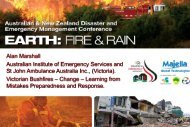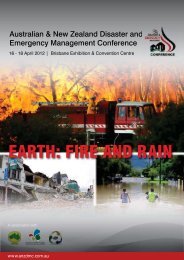Book of Abstracts 2013 - Australian and New Zealand Disaster ...
Book of Abstracts 2013 - Australian and New Zealand Disaster ...
Book of Abstracts 2013 - Australian and New Zealand Disaster ...
Create successful ePaper yourself
Turn your PDF publications into a flip-book with our unique Google optimized e-Paper software.
Auckl<strong>and</strong>ers will also receive advance notification <strong>of</strong> impending disasters such as tsunamis <strong>and</strong> cyclones, as well as<br />
important information following a major catastrophe such as an earthquake.<br />
Ms Julie Molloy<br />
Director, Social Engagements, Volunteering Qld<br />
The Role <strong>of</strong> NGOs in Building Sustainable Community Resilience<br />
This paper will discuss the broad role that impact driven NGOs can play in disaster management <strong>and</strong> sustainable<br />
community resilience building through an exploration <strong>of</strong> the findings <strong>and</strong> impacts <strong>of</strong> the largest community resilience<br />
building program in Australia, led by a non-government organisation.<br />
Planning for crisis management, business continuity <strong>and</strong> protection <strong>of</strong> infrastructure <strong>and</strong> assets only make up part <strong>of</strong><br />
the larger picture that is sustained community resilience. Social capital, community competence <strong>and</strong> local leadership<br />
capacity are critical to a community’s capability to prepare, mitigate, respond <strong>and</strong> recover from disaster. These<br />
qualities are the social infrastructure which should inform <strong>and</strong> in many ways underpin the foundation <strong>of</strong> any hard<br />
infrastructure. However, in order to attain these adaptive capacities, long-term community development <strong>and</strong> capacity<br />
building strategies are required.<br />
There are inherent challenges for disaster management agencies trying to engage communities in dialogue around<br />
planning risk-informed response <strong>and</strong> recovery plans for disasters. Limited resources <strong>of</strong>ten inhibit the capacity <strong>of</strong><br />
emergency services to undertake community education <strong>and</strong> engagement activities which <strong>of</strong>ten sit outside their core<br />
business as response agencies.<br />
NGOs contrastingly are ideally placed to work in <strong>and</strong> with the communities which they service, to educate <strong>and</strong> support<br />
them at all stages <strong>of</strong> disaster management. Importantly, NGOs already engage with a large majority <strong>of</strong> those members in<br />
community which would be most vulnerable in disasters <strong>and</strong> have an ongoing <strong>and</strong> trusted presence in the community.<br />
This paper will argue that NGOs are uniquely placed to work in <strong>and</strong> with community over the long term in order to<br />
develop the adaptive capacities, whilst advocating for the need to create stronger partnerships <strong>and</strong> more significant<br />
funding opportunities for the sector to engage in resilience building activities.<br />
Providing evidence based look at the outcomes <strong>and</strong> learning’s from over six unique programmatic approaches to<br />
building community resilience to natural disasters; Describing the methodology <strong>and</strong> systems that support this<br />
qualitative work, allowing for scalability <strong>and</strong> sustainability.<br />
Dr Krishna Nadimpalli<br />
Team Leader, Geoscience Australia<br />
Co Authors - Mr Martin Wehner, Structural Engineer, Geoscience Australia. Dr Paolo Gamba, Associate Pr<strong>of</strong>essor,<br />
University <strong>of</strong> Pavia.<br />
Global Exposure Database to Underpin Earthquake Risk Assessment Worldwide<br />
Global Earthquake Model (GEM) foundation is developing tools <strong>and</strong> resources for worldwide earthquake risk<br />
assessment. The tools will allow users to apply both probabilistic <strong>and</strong> deterministic methods to estimate losses.<br />
Exposure data is a critical component in the model. GEM has set up a project (GED4GEM) to develop a Global Exposure<br />
Database (GED) that consists <strong>of</strong> global building stock <strong>and</strong> population distribution. This database has been designed to<br />
include the spatial, structural characteristics, repair cost <strong>and</strong> occupancy related information that underpins damage,<br />
loss <strong>and</strong> human casualty estimation models. The project is being undertaken by the GED4GEM consortium with






